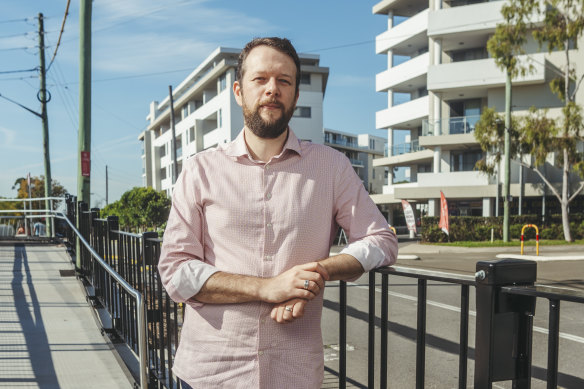‘A future of dead plants’: Pitch to scrap unit sunlight standards criticised
By Julie Power
A call by the NSW Productivity Commission to remove a requirement that most apartments have some direct sunlight would create two classes of residents, critics say: those who can afford to live in the light and those who will dwell in the dark.
The commission’s review of housing supply last month backed the relaxation of design requirements for apartments that its stakeholders, mostly builders and developers, argued would reduce costs and improve supply and affordability.
Among its recommendations was a proposal to scrap the “solar access” requirement for apartments. Currently, the NSW Apartment Design Guide requires most apartments in a building to receive at least two hours of direct sunlight a day in main living areas.

Committee for Sydney chief executive Eamon Waterford lives in a suburb full of new apartments. Credit: Dion Georgopoulos
Committee for Sydney chief executive Eamon Waterford said the removal of standards would be like going back to the bad old days of windowless units, similar to the so-called “dog box apartments” banned in Victoria eight years ago.
“If this goes ahead, we’re looking at a future full of apartments with dead plants,” he said.
Apartment expert and UNSW professor Phil Oldfield said the proposal could usher in a generation of poor-quality, uncomfortable and lower-amenity homes.
“It runs the risk of creating two tiers of apartments: those that are warm and healthy, with sun and amenity, and those that are cold and dark,” he said.
Oldfield is one of several planners, architects, and academics with Waterford’s Committee for Sydney who say the commission did not consult them.
Prominent Sydney architect Philip Thalis launched an attack on the proposal on X on Monday, saying NSW’s apartment design standards were in “danger of being trashed by a terrible NSW Productivity Commission report”.
Many architects support some of the commission’s recommendations, particularly the proposal to remove the minimum number of parking spots for an apartment building and a further increase in the height of blocks proposed as part of NSW’s Transport Oriented Development program.
However, there are concerns that changes to amenities and design would reduce quality, discourage a move to apartment life, encourage lazy design, and have little impact on prices.
To create a “pro-housing regulatory environment”, the commission said it was a priority to “relax design-related requirements ... that weigh on feasibility, such as car parking, solar access, and minimum apartment size”.
“Not all NSW residents can afford or want to pay for a spacious, sunny apartment with a car spot,” it said.
Professor Oldfield said without the guidance of the Apartment Design Guide, the result was poor apartments.
Before Victoria introduced its equivalent regulations – BADS (Better Apartment Design Standards) – in 2017, some apartment blocks with windowless bedrooms were likened to vertical slums.
“It runs the risk of creating two tiers of apartments: those that are warm and healthy ... and those that are cold and dark.”
UNSW Professor Phil Oldfield
Oldfield was critical of the suggestion to “let consumers decide”.
NSW’s Apartment Design Guide is a guide and a companion to existing regulations.
It suggests studio apartments should be a minimum of 35 square metres, one-bedrooms should be 50 sq m, two-bedrooms should be 70 sq m, and three-bedrooms should be 90 sq m.
NSW requires every habitable room to have a window and suggests that 60 per cent of apartments in new developments have cross ventilation and 70 per cent have at least two to three hours of sunlight a day in winter.
“Ask anyone who lives in apartment what they like or would like more of, and it’s probably one of two things – sunlight and fresh air,” Waterford said.
The Productivity Commission said the cost of delivering a new apartment in a typical mid-rise apartment block in Sydney had increased from $666,000 in 2018 to $905,000 in 2023.
‘Bad outcome’
But Adam Haddow, national president-elect of the Australian Institute of Architects said the changes proposed would “cause a rush out of apartments at a time when we need people rushing into them” by reducing regulations around design quality and amenity.
“It is just a really short walk to a bad outcome,” said Haddow, whose firm SJB has won multiple awards for its multi-use residential apartments.
NSW’s Apartment Design Guide already allows 15 per cent of apartments in a block to not experience direct sunlight. Where a block faces south or is surrounded by high rises in the inner city, the percentage may be much higher.
Australia’s National Construction Code allows developers to build units without windows in some rooms if they can “borrow light” from an adjoining room. But the NSW design guide does not: It requires ventilation, windows, and sunlight in many habitable rooms.
Haddow said relaxing these guidelines was a slippery slope.
Premier Chris Minns’ office would not comment on when the state government would respond to the review.
The Morning Edition newsletter is our guide to the day’s most important and interesting stories, analysis and insights. Sign up here.